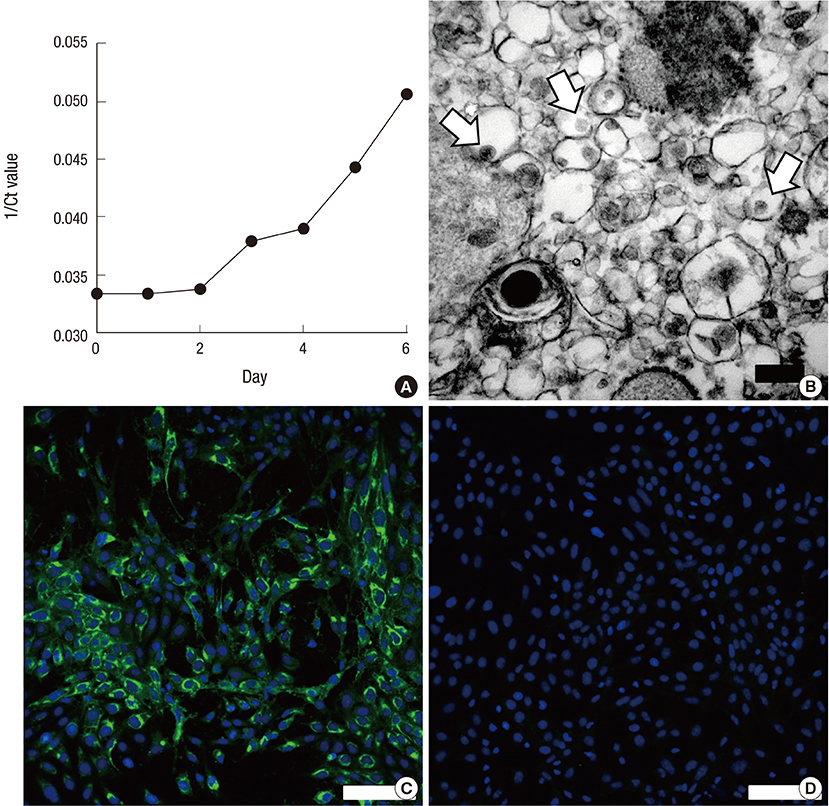J Korean Med Sci.
2016 Jul;31(7):1173-1177. 10.3346/jkms.2016.31.7.1173.
First Imported Case of Zika Virus Infection into Korea
- Affiliations
-
- 1Department of Infectious Diseases, Chonnam National University Medical School, Gwangju, Korea.
- 2Department of Internal Medicine, Seoul National University College of Medicine, Seoul, Korea. mdohmd@snu.ac.kr
- 3Center for Pathology and Immunology, National Institute of Health, Korea Centers for Disease Control and Prevention, Osong, Korea.
- 4Department of Pediatrics, Seoul National University College of Medicine, Seoul, Korea.
- KMID: 2373741
- DOI: http://doi.org/10.3346/jkms.2016.31.7.1173
Abstract
- Since Zika virus has been spreading rapidly in the Americas from 2015, the outbreak of Zika virus infection becomes a global health emergency because it can cause neurological complications and adverse fetal outcome including microcephaly. Here, we report clinical manifestations and virus isolation findings from a case of Zika virus infection imported from Brazil. The patient, 43-year-old Korean man, developed fever, myalgia, eyeball pain, and maculopapular rash, but not neurological manifestations. Zika virus was isolated from his semen, and reverse-transcriptase PCR was positive for the virus in the blood, urine, and saliva on the 7th day of the illness but was negative on the 21st day. He recovered spontaneously without any neurological complications. He is the first case of Zika virus infection in Korea imported from Brazil.
Keyword
MeSH Terms
Figure
Cited by 3 articles
-
Systems Biology-Based Platforms to Accelerate Research of Emerging Infectious Diseases
Soo-Jin Oh, Young-Ki Choi, Ok Sarah Shin
Yonsei Med J. 2018;59(2):176-186. doi: 10.3349/ymj.2018.59.2.176.An Update on Zika Virus in Asia
Sl-Ki Lim, Jacqueline Kyungah Lim, In-Kyu Yoon
Infect Chemother. 2017;49(2):91-100. doi: 10.3947/ic.2017.49.2.91.소변 검체를 이용한 careGENE™ 지카바이러스 RT-PCR 키트의 성능평가
Gun Woo Kim, Borae G. Park, Seung Yeon Kwak, Woong Sik Jang, Jeounghun Nam, Chae Seung Lim
Lab Med Online. 2021;11(4):267-274. doi: 10.47429/lmo.2021.11.4.267.
Reference
-
1. Dick GW, Kitchen SF, Haddow AJ. Zika virus. I. Isolations and serological specificity. Trans R Soc Trop Med Hyg. 1952; 46:509–520.2. MacNamara FN. Zika virus: a report on three cases of human infection during an epidemic of jaundice in Nigeria. Trans R Soc Trop Med Hyg. 1954; 48:139–145.3. Duffy MR, Chen TH, Hancock WT, Powers AM, Kool JL, Lanciotti RS, Pretrick M, Marfel M, Holzbauer S, Dubray C, et al. Zika virus outbreak on Yap Island, Federated States of Micronesia. N Engl J Med. 2009; 360:2536–2543.4. Oehler E, Watrin L, Larre P, Leparc-Goffart I, Lastere S, Valour F, Baudouin L, Mallet H, Musso D, Ghawche F. Zika virus infection complicated by Guillain-Barre syndrome--case report, French Polynesia, December 2013. Euro Surveill. 2014; 19:20720.5. European Centre for Disease Prevention and Control. Zika virus infection outbreak, French Polynesia: rapid risk assessment [Internet]. accessed on 23 May 2016. Available at http://ecdc.europa.eu/en/publications/Publications/Zika-virus-French-Polynesia-rapid-risk-assessment.pdf.6. Campos GS, Bandeira AC, Sardi SI. Zika virus outbreak, Bahia, Brazil. Emerg Infect Dis. 2015; 21:1885–1886.7. Schuler-Faccini L, Ribeiro EM, Feitosa IM, Horovitz DD, Cavalcanti DP, Pessoa A, Doriqui MJ, Neri JI, Neto JM, Wanderley HY, et al. Possible association between Zika virus infection and microcephaly - Brazil, 2015. MMWR Morb Mortal Wkly Rep. 2016; 65:59–62.8. World Health Organization. Zika situation report [Internet]. accessed on 23 May 2016. Available at http://who.int/emergencies/zika-virus/situation-report/19-may-2016/en/.9. Graham L, Orenstein JM. Processing tissue and cells for transmission electron microscopy in diagnostic pathology and research. Nat Protoc. 2007; 2:2439–2450.10. Hamel R, Dejarnac O, Wichit S, Ekchariyawat P, Neyret A, Luplertlop N, Perera-Lecoin M, Surasombatpattana P, Talignani L, Thomas F, et al. Biology of Zika virus infection in human skin cells. J Virol. 2015; 89:8880–8896.11. Driggers RW, Ho CY, Korhonen EM, Kuivanen S, Jääskeläinen AJ, Smura T, Rosenberg A, Hill DA, DeBiasi RL, Vezina G, et al. Zika virus infection with prolonged maternal viremia and fetal brain abnormalities. N Engl J Med. Forthcoming. 2016.12. Petersen LR, Jamieson DJ, Powers AM, Honein MA. Zika virus. N Engl J Med. 2016; 374:1552–1563.13. Brasil P, Pereira JP Jr, Raja Gabaglia C, Damasceno L, Wakimoto M, Ribeiro Nogueira RM, Carvalho de Sequeira P, Machado Siqueira A, Abreu de Carvalho LM, Cotrim da Cunha D, et al. Zika virus infection in pregnant women in Rio de Janeiro - preliminary report. N Engl J Med. Forthcoming. 2016.14. Broutet N, Krauer F, Riesen M, Khalakdina A, Almiron M, Aldighieri S, Espinal M, Low N, Dye C. Zika virus as a cause of neurologic disorders. N Engl J Med. 2016; 374:1506–1509.15. Carteaux G, Maquart M, Bedet A, Contou D, Brugières P, Fourati S, Cleret de Langavant L, de Broucker T, Brun-Buisson C, Leparc-Goffart I, et al. Zika virus associated with Meningoencephalitis. N Engl J Med. 2016; 374:1595–1596.16. Interim guidance for Zika virus testing of urine - United States, 2016. MMWR Morb Mortal Wkly Rep. 2016; 65:474.17. Bingham AM, Cone M, Mock V, Heberlein-Larson L, Stanek D, Blackmore C, Likos A. Comparison of test results for Zika virus RNA in urine, serum, and saliva specimens from persons with travel-associated Zika virus disease - Florida, 2016. MMWR Morb Mortal Wkly Rep. 2016; 65:475–478.18. Lanciotti RS, Kosoy OL, Laven JJ, Velez JO, Lambert AJ, Johnson AJ, Stanfield SM, Duffy MR. Genetic and serologic properties of Zika virus associated with an epidemic, Yap State, Micronesia, 2007. Emerg Infect Dis. 2008; 14:1232–1239.19. Atkinson B, Hearn P, Afrough B, Lumley S, Carter D, Aarons EJ, Simpson AJ, Brooks TJ, Hewson R. Detection of Zika virus in semen. Emerg Infect Dis. 2016; 22:940.20. Mansuy JM, Dutertre M, Mengelle C, Fourcade C, Marchou B, Delobel P, Izopet J, Martin-Blondel G. Zika virus: high infectious viral load in semen, a new sexually transmitted pathogen? Lancet Infect Dis. 2016; 16:405.
- Full Text Links
- Actions
-
Cited
- CITED
-
- Close
- Share
- Similar articles
-
- Zika Virus Infection: Perspectives as a Specialist of Pediatric Infectious Diseases
- Estimation of the Size of Dengue and Zika Infection Among Korean Travelers to Southeast Asia and Latin America, 2016–2017
- Zika virus Infection: New Threat in Global Health
- Zika Virus Infection
- The current status of Zika virus in Southeast Asia



